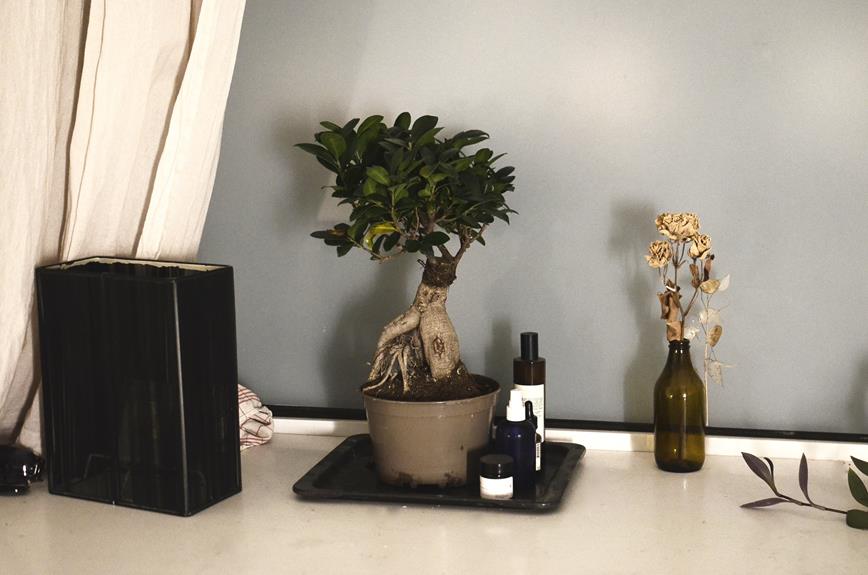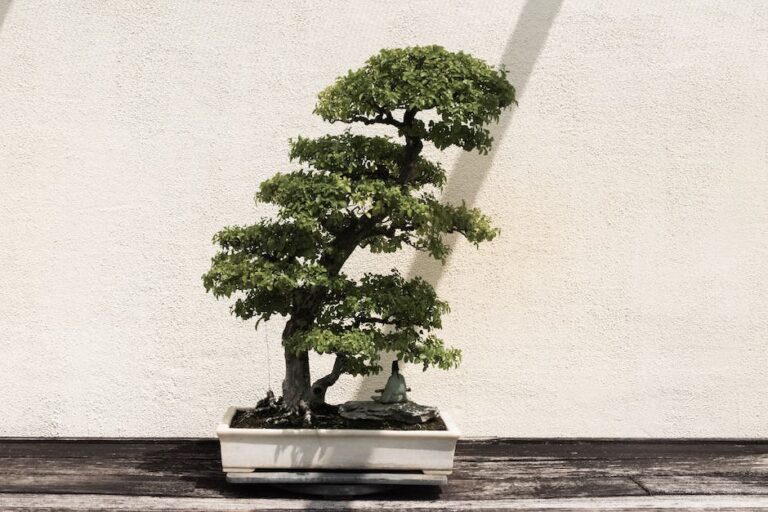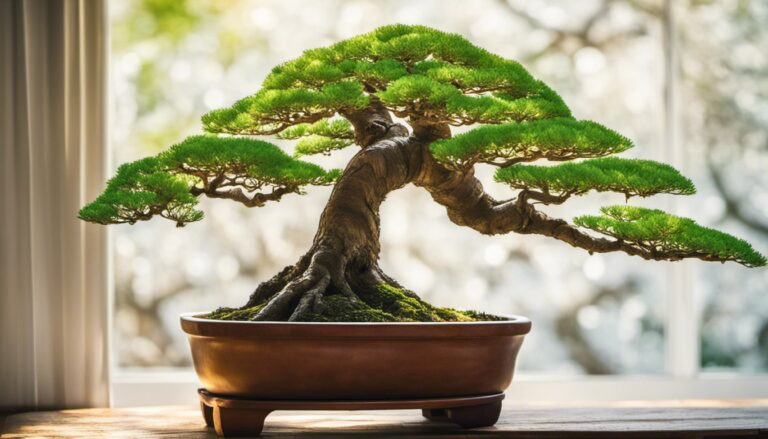Mastering Ficus Ginseng Bonsai Care (Grow and Care)
So, you’ve recently brought home a stunning Ficus Ginseng Bonsai and want to ensure it thrives under your care. Mastering Ficus Ginseng Bonsai Care will empower you to nurture this captivating plant with confidence and expertise.
This guide provides essential tips for creating the perfect environment, watering, fertilizing, and overall maintenance to help your bonsai flourish.
As you delve into the art of Ficus Ginseng Bonsai care, you’ll discover the joy of cultivating a vibrant miniature tree that brings tranquility to your home.
Let’s delve into the fascinating world of Ficus Ginseng Bonsai and unlock the secrets to its successful care.
Understanding Ficus Ginseng Bonsai

Once you comprehend the nature and requirements of Ficus Ginseng Bonsai, you’ll be better equipped to care for this unique plant in your home.
Ficus Ginseng Bonsai, belonging to the mulberry family, is known for its tolerance of neglect and is a popular choice for indoor gardening. These bonsais come in various varieties and add a touch of natural elegance to interior decor.
Originating from tropical regions, they’re miniature versions of large trees and require regular pruning to maintain their shape and health. To thrive, they need warmth, plenty of light, and high temperatures with moderate watering and fertilization.
With its low-maintenance nature, Ficus Ginseng Bonsai offers all the joy of bonsai without the drama, making it an ideal choice for houseplant enthusiasts.
Origin and Growth
To understand the origin and growth of Ficus Ginseng Bonsai, you should know that there are between 800 and 2000 varieties of Ficus spread across tropical continents. Ficus Ginseng Bonsai is native to tropical regions and typically grows as large trees in the wild.
Bonsai trees are miniature versions of these large trees and require regular pruning to maintain their shape and health. It’s important to repot the plant annually to promote quicker growth.
These bonsais are a result of careful cultivation and training to achieve their distinctive tree-like appearance. Understanding their natural habitat and growth patterns will help you provide the ideal conditions for your Ficus Ginseng Bonsai, ensuring it thrives in your care.
Ideal Environmental Conditions
Maintain consistent high temperatures and ample sunlight to create ideal environmental conditions for your Ficus Ginseng Bonsai. This bonsai can’t tolerate frost, so it’s crucial to keep it warm all year-round.
During the summer, it can thrive outdoors in temperatures above 15°C, but it requires a lot of light and does best in full sunshine. While it can tolerate lower humidity levels, consistent high temperatures are essential. Creating a humid environment and avoiding drafts will benefit the bonsai’s health.
When it comes to watering, moderate watering is recommended, allowing the soil to dry before watering again. Along with proper watering, weekly fertilization during the growing season and monthly fertilization in winter will help maintain the bonsai’s health and vigor.
Watering and Fertilizing Tips
When caring for your Ficus Ginseng Bonsai, it’s important to ensure moderate watering and proper fertilization to maintain its health and vigor. Aim for moderate watering, allowing the soil to partially dry before watering again. This helps prevent over-watering, which can lead to root rot, and under-watering, which can cause the tree to wither.
Additionally, daily misting can maintain humidity levels and deter dust-mites. During the growing season, weekly fertilization supports healthy growth, while monthly fertilization in winter is beneficial. However, be cautious with misting, as excessive moisture can promote fungal diseases.
Benefits of Ficus Ginseng Bonsai
Enjoying the low-maintenance care of a Ficus Ginseng Bonsai enhances your indoor gardening experience. This bonsai offers numerous benefits, making it a delightful addition to your home.
Its unique and intricate tree-like structure adds a touch of natural beauty to any room, creating a calming and serene atmosphere.
Ficus Ginseng Bonsai also serves as a conversation starter, showcasing your appreciation for artful cultivation.
Its adaptability to various light conditions and tolerance of neglect make it an ideal choice for beginners and busy individuals. Additionally, the bonsai’s resilience to occasional over- or under-watering provides peace of mind, reducing the stress of plant care.
Pruning and Shaping Techniques
To master the care of your Ficus Ginseng Bonsai, understanding pruning and shaping techniques is essential for maintaining its unique and intricate tree-like structure.
Regular pruning helps maintain the shape and health of the bonsai, allowing you to control its growth and development. To prune your bonsai, start by inspecting the tree for any dead, damaged, or overgrown branches. Use sharp, clean shears to carefully trim these areas, ensuring smooth cuts to promote faster healing.
Additionally, shaping techniques such as wiring can be used to guide the direction of growth and create the desired aesthetic appeal.
Repotting Guidelines
How frequently should you repot your Ficus Ginseng Bonsai for optimal growth and health?
Repotting your Ficus Ginseng Bonsai annually, ideally in the spring, is crucial for its well-being. As the bonsai grows, it becomes root-bound, hindering its ability to absorb nutrients and water.
When repotting, prune the roots to encourage new growth and replace the soil to replenish nutrients. Select a new pot that’s slightly larger than the current one to accommodate the growing root system. Ensure the new pot has sufficient drainage holes to prevent waterlogging.
After repotting, water the bonsai thoroughly and place it in a shaded area for a few weeks to minimize stress. Repotting is a key aspect of Ficus Ginseng Bonsai care, promoting healthier and more vigorous growth.
Pest and Disease Management
You should regularly inspect your Ficus Ginseng Bonsai for pests and diseases to maintain its health and vitality. Look for common pests such as spider mites, aphids, and scale insects. If you notice any signs of infestation, promptly treat your bonsai with insecticidal soap or neem oil.
Additionally, be on the lookout for common diseases like powdery mildew and leaf spot. Ensure proper air circulation and avoid overwatering to prevent these issues. If you spot any signs of disease, carefully remove the affected areas and consider using a fungicidal spray.
Regularly cleaning the foliage and keeping the bonsai in optimal growing conditions will also help prevent pest and disease problems, keeping your Ficus Ginseng Bonsai healthy and thriving.
Displaying Your Ficus Ginseng Bonsai
After ensuring the health and vitality of your Ficus Ginseng Bonsai through regular inspection and pest management, it’s time to consider the best way to display it in your indoor space.
Choose a location with plenty of natural light, such as near a south-facing window, to ensure the bonsai receives adequate sunlight.
Consider using a stylish and appropriately sized bonsai pot or tray to complement your interior decor.
Elevating the bonsai on a stand or placing it on a decorative surface can enhance its visual appeal.
Rotate the bonsai occasionally to promote even growth and prevent it from leaning towards the light source.
Resources for Bonsai Enthusiasts
To further enhance your expertise in Ficus Ginseng Bonsai care, explore a variety of resources tailored for bonsai enthusiasts.
Online forums and communities provide a platform to exchange knowledge, seek advice, and share experiences with other enthusiasts.
Books and magazines dedicated to bonsai cultivation offer in-depth insights, tips, and techniques for nurturing your Ficus Ginseng Bonsai.
Local bonsai clubs and workshops can provide hands-on learning experiences and networking opportunities with experienced growers.
Additionally, online retailers offer a wide range of bonsai tools, fertilizers, pots, and other essential accessories for your Ficus Ginseng Bonsai.
Consider subscribing to newsletters from reputable bonsai websites to stay updated on the latest trends, care techniques, and exclusive offers for bonsai enthusiasts.
Best Guides
The ficus ginseng bonsai tree is a popular variety for bonsai enthusiasts due to its unusual twisted root structure above ground that resembles the gnarled roots of ginseng plants. With proper care, a ficus ginseng bonsai can develop an impressive, aged look over many years. Here are some tips for mastering ficus ginseng bonsai care:
Light Ficus ginseng bonsai trees require bright, indirect light (source 1). East or west-facing windows are ideal, as long as the tree is not in direct sun, which can scorch the leaves. Provide at least 6 hours of sunlight per day for healthy growth (source 2).
Watering
Keep the soil lightly moist but not soggy wet (source 3). Water when the top inch of soil is dry. Overwatering is a common cause of root rot in ficus bonsai, so allow the soil to dry out between waterings (source 4).
Fertilizer
Apply a balanced liquid fertilizer diluted to half or quarter strength every 2-4 weeks during the growing season from spring to fall (source 5). Too much fertilizer can burn the roots.
Repotting Repot the tree every 2-3 years in early spring before new growth begins (source 6). Gently loosen the root ball and trim any circling or kinked roots before replanting at the same depth.
Pruning Prune shoots back to 1-2 leaves in spring to encourage dense, compact growth. Remove any leaves or branches as needed to maintain the desired shape throughout the growing season (source 7).
Overwintering
Protect from frost and bring indoors before first fall frost. Continue to water sparingly and do not fertilize over winter when growth slows ([source 8](https://www.bonsaioutlet
Conclusion
Now that you’ve learned the ins and outs of Ficus Ginseng Bonsai care, you’re well-equipped to nurture and enjoy your miniature tree.
With the right knowledge and techniques, you can create the perfect environment for your bonsai to thrive.
From understanding its origin and growth to managing pests and diseases, you’re ready to take on the rewarding journey of caring for your Ficus Ginseng Bonsai.
Happy gardening!



